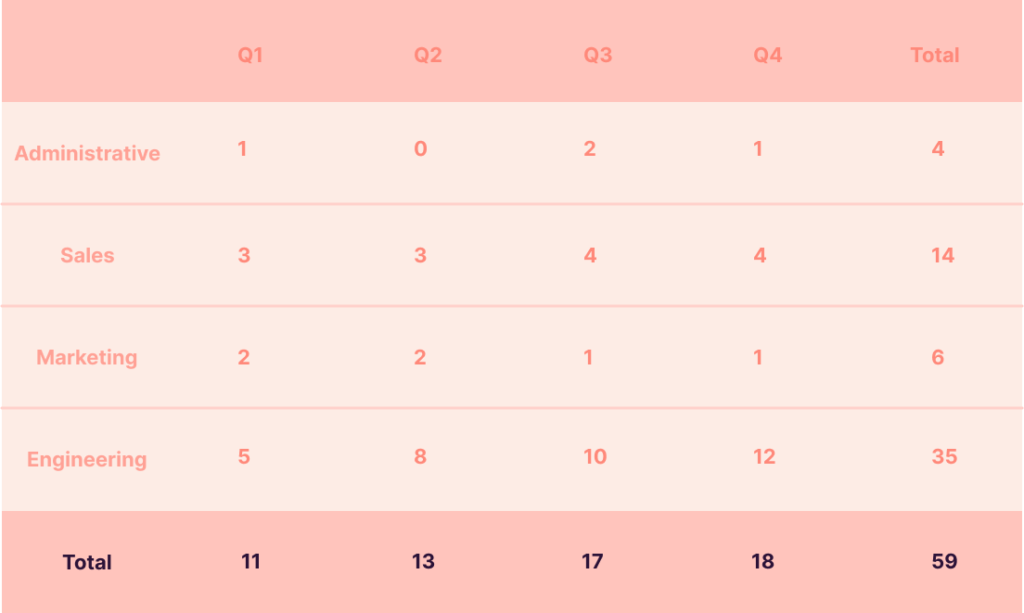Like everything in business, recruitment costs money. Thanks to the pandemic, the competition to secure the best talent has never been more fierce. With the pandemic also causing many businesses to tighten up their budgets, it’s more important than ever to get good at calculating recruitment costs.
In this article, we’ll give you the full rundown on how to calculate your recruitment costs in a simple guide. We’ll cover everything from how to identify the right recruitment costs all the way through to the cost benchmarks across industry.
Ready to get started?
Quick Links:
- Which Recruitment Costs Should Be Included?
- 5 Steps for Calculating Recruitment Costs
- What’s a Good Cost Per Hire Benchmark?
- 3 Additional Recruitment Cost Considerations
Which Costs Should Be Included?
Before we get into any calculations, we need to understand what costs should be included when considering your cost per hire. Unfortunately, many recruitment managers fall at the first hurdle by missing out several different costs which end up creating a false metric.
Costs are typically broken down as internal and external. Here is a list of each type that needs to be considered when building your recruitment cost forecast.
Internal Recruitment Costs
- Recruiter salaries – If your recruiters spend 100% of their time recruiting, this is an easy one. However, if they take on separate responsibilities, say within HR, marketing or PR, remember to only factor in the percentage of their time (and ultimately, their cost) that’s dedicated to recruiting.
- Recruiter bonuses – Depending on your bonus/commission setup, ensure you factor in any additional payments you’ll make to your recruitment team members for delivering a successful hire.
- Referral Fees – If you have an employee referral scheme, remember to factor in those costs as well. Many organizations offer anywhere between $500 – $1,000 if an employee refers someone who goes on to be hired.
External Recruitment Costs
- Advertising Fees – Whether through job boards or social media advertising, the money you spend promoting your vacancy needs to be included when calculating any recruitment costs.
- Agency Fees – If you use an agency to support the sourcing process, their costs are critical to include. Depending on your setup, that may be a fixed fee or a % of the agreed employee’s salary. If it’s the latter, it’s always worth taking an average of the highest and lowest salaries you’re willing to pay to help you estimate accurately.
- Software Licences – If you use a software tool to manage your hiring process, those costs have to be included. However, like with resourcing, if you use a tool that also provides other services to your business (i.e. a CRM), you should only absorb the portion of that cost relevant to recruitment.
- Event Costs – If part of your recruitment strategy focuses on sourcing candidates at events, you must factor in those costs. Even if a direct-hire doesn’t come from the event itself, it still forms part of your wider recruitment strategy costs and, as such, needs to be considered in your calculations.
- Candidate Expenses – If you’re expecting candidates to travel great distances to attend interviews, consider how you will re-reimburse their costs. If you decide to cover the costs of flights, hotels or food, you’ll need to factor in those costs too.
5 Steps for Calculating Recruitment Costs
Now that we know the sort of expenses that make up your entire recruitment cost base, it’s time to work through a step-by-step guide on calculating your cost per hire.
#1 – Start with the Formula
The cost per hire formula is a pretty simple one on face value, but a few different variables go into bringing it all together.

Given that we’ve already covered the essential internal and external recruiting costs let’s start working out your total number of hires.
#2 – Forecast Your Future Hires
If you’re looking to calculate your cost per hire over a more extended period of time, you’ll first need to get to grips with your business’ resourcing profile.
By talking to senior executives, department leads and hiring managers, you can get a good idea of not only the current number of people across your business but also the people’s plans for the future.
Department leads will know the current number of individuals in each team and whether their numbers are remaining static or subject to change in the short term. On the other hand, senior executives will have a more strategic view of the company and give insight into future growth plans or transformation initiatives that may need extra staff.
Then, of course, there’s natural staff turnover. Hopefully, you’ll have some past data to lean on to understand the natural churn of employees within your organization. If not, the average US turnover rate sits at around 12-15%.
With those areas covered, it works best to plot the number of expected hires by department in a table. You’ll see an example of this below.

That’s the bottom part of the formula complete!
#3 – Plug in Those Costs
Now it’s time to complete the top row of the formula by bringing together the internal and external recruitment costs.
Remember that of those costs we looked at earlier on, some will be fixed, and some will be variable based on your number of hires.
For example, your employee’s basic salary will be fixed as it doesn’t change based on the number of candidates they source. On the other hand, advertising costs will be incurred incrementally based on the number of vacancies you post.
Once you’ve added all those costs together, you’ll have your total costs and have now completed your formula.
#4 – Do the Maths
It’s now time to do the maths and work out your cost per hire. While it’s a pretty easy formula to execute, you’ll still need a calculator to hand as it’s unlikely to be a manageable round number.
Here are a few examples:
$80,000 (Costs) / 18 (Hires) = $4,444.44
$300,000 (Costs) / 53 (Hires) = $5,660.38
$10,000 (Costs) / 8 (Hires) = $1,250
If you want to dive deeper into your analysis, try breaking your costs and number of hires down by business area. This insight may help you identify hires that are more expensive to execute and may give you some ideas of areas to optimize.
#5 – Track & Monitor
Tracking cost per hire doesn’t end after the first calculation. We’d recommend tracking your recruitment costs over time to help you spot trends, identify waste and streamline your process.

As competition for talent increases, it may become too expensive to deliver your recruitment strategy in a certain way.
It’s also worth remembering that once you reach a certain threshold of costs and number of hires, as a business, you may be better off bringing your operational internal rather than using external recruitment agencies.
What’s a Good Cost Per Hire Benchmark?
Even though there’s no hard and fast average for cost per hire, studies have shown that, on average, businesses pay around $4,000 to bring in each new hire.
That might sound like a lot, but given most agencies will charge somewhere between 10% and 30% of an employee’s final salary, it’s easy to see how quickly cost per hire can go sky-high.
But of course, this won’t be the same for everyone. There is a range of different factors that affect the cost per hire, which include:
- Industry – Naturally, different industries command different levels of expertise, and thus their employees command higher salaries. Cost per hire in a legal profession could easily be 4-5x higher than those recruiting into manufacturing.
- Business Size – Economies of scale can also be leveraged on recruiting costs, with corporate organizations able to spread their operating costs out across a large number of hires. That scale can also mean cheaper unit costs on things like software tools or the ability to negotiate cheaper agency deals.
- Location – In any country, you’ll find a disparity in the cost of operation, and that’ll fit your recruitment budgets too. Especially when you compare costs in Europe vs Asia, it’s easy to see how location can significantly lower or raise all aspects of recruitment cost.
- Position Mix – Senior hires inevitably cost more money to hire. If your organisation is top-heavy with managers and executives, expect your cost per hire to increase. On the other hand, more junior employees, or positions you can hire in bulk, can be more cost-effective per hire.

3 Additional Considerations for Calculating Recruitment Costs
Many businesses focus their recruitment performance entirely on costs. While the cost per hire gives a great indication of the value of hiring, it doesn’t tell the whole story when calculating recruitment costs.
Here are a few other things to consider when looking holistically at ‘recruitment cost’.
#1 – Opportunity Cost of Non-Dedicated Teams
Especially in smaller businesses, you may not have a dedicated individual (or team of individuals) to manage the recruitment process. Because of this, another member of your business, maybe even the managing director, will pick up the job on finding your next hire.
While you may factor their salary into your internal recruitment costs, it’s also worth considering the opportunity cost of their time not being used for their everyday work.
For example, if your best salesperson spends half their day interviewing candidates, how many deals have they missed out on closing? Many would argue an indirect cost such as this should enter your recruitment cost calculations, but that isn’t standard practice across the board.
#2 – Quality vs Cost
You get what you pay for. An age-old saying that’s as true in recruitment as in any other part of business.
Many recruitment leaders focus on driving down their recruitment costs, hoping that they can do more for less. And while recruiters may still bring new hires into the business, often the hiring managers suffer due to a lack of candidate quality.
Ultimately, acquiring talent is all about getting great people into your business who don’t just have the skills to perform the role but align with your organization’s culture and values. Getting this wrong can actually cost the company more money further down the line due to a lack of productivity and a slower learning curve.
But what can you do to boost candidate quality? Why not try adding skills testing into your end-to-end recruitment process?
It’s super easy to set up, can be bespoke to each vacancy and provides a lot more value than resumes alone. Here’s a 60-second video below on how we do it at Toggl Hire.
#3 – Speed vs Cost
Do you know the cost a vacancy has to your business? Especially if it has arisen from someone leaving, having a hole in one of your teams may be costing the business money on a daily basis.
Again, if the focus is on cost within your recruitment process, it could actually increase your time to hire, meaning it takes longer to fill that vacancy.
It’s worth considering whether it’s more cost-effective to invest more money to get your new hire in faster rather than incurring costs on an open vacancy.
Summary
When it comes to getting a grip on calculating recruitment costs, it’s not always easy to get it right. While the cost per hire metric is a simple one, getting the data right on your costs and hiring forecast is the key to building a solid metric.
Optimizing your cost per hire is a great way to boost efficiency in your end-to-end recruitment process, identifying areas of waste that can be cut.
But it’s important to remember that cost isn’t everything. Driving costs down in one area can lead to unexpected costs in others, with the knock-on effects of candidate quality and time to hire something that should be factored in as well!
James Elliott is a Strategy Manager and Writer from London, UK. When not working on the day job, James writes on a variety of business and project management topics with a focus on content that enables readers to take action and improve their ways of working. You can check out James’ work on his website or by connecting on LinkedIn.


